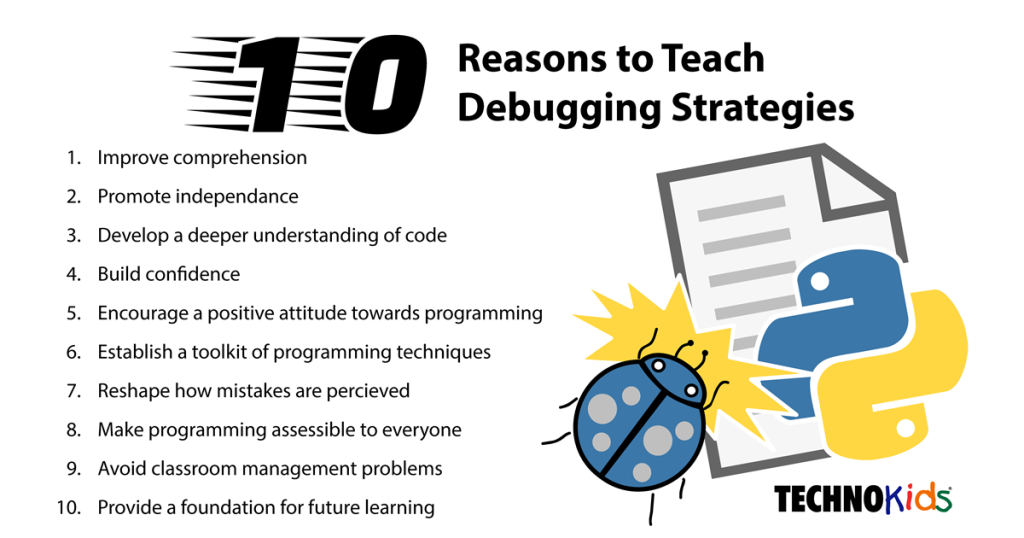Teach debugging strategies to beginners. This will enhance the learning experience. The instruction should be evident and apparent to the students. Instead of hoping that young programmers will discover techniques, guide them through proven methods to find and fix errors.
10 Reasons to Teach Debugging Strategies
There are many benefits to deliberately teaching debugging strategies at the start of a programming unit:
1. Improve Comprehension
Teaching debugging strategies to beginners allows them to make sense of the Python programming language. Similar to reading comprehension, explicit strategy instruction, gives student the skills they need understand text. They learn how to decode the meaning of the error messages and apply techniques to correct the code.
2. Promote Independence
Guiding students through exercises where they break and then repair the code, promotes independent practice. During the activity, young programmers receive instant feedback about what makes code work. This allows them to take control of their own learning.
3. Develop a Deeper Understanding of Code
Young kids are always asking “Why?” As they grow older, they may not ask the question aloud as often but they continue to wonder about their world. When they are taught debugging strategies they begin to form connections to why a line of code must be written in a particular way. They understand the purpose for quotes, brackets, indents, and hashtags. Ultimately, this makes them better programmers.
4. Build Confidence
Young programmers can quickly become discouraged when their programs do not run. In the IDLE Python environment mistakes are highlighted in red with boxes that tell you instantly there is an error. This information on the screen is helpful if a learner knows how to apply it to correct the problem. However, if the meaning of the errors are unknown then they look like gibberish. Instead of having students struggle and give up, teach them strategies they can use to find and fix errors. Each success will build confidence.
5. Encourage a Positive Attitude Towards Programming
One of the goals to teaching programming to elementary and middle school students is to spark an interest in STEM. To ignite a passion for coding, the experience should be fun. Glaring at an error message with no idea how to fix the problem is not enjoyable. In fact, if it goes on too long it can make a novice dislike programming. Teaching students about common errors is empowering. They can make their programs run and see the results of their efforts, which is a great feeling.
6. Establish a Toolkit of Programming Techniques
The same debugging strategy cannot be applied to every problem. For example, Trial and Error is a wonderful way to test ideas. However, it can be inefficient when the issue is a loop missing indented instructions. Provide students with a multitude of strategies and explain when they are most effective. This will enable programmers to thoughtfully debug their programs using a toolkit full of techniques.
7. Reshape How Mistakes How Perceived
Children often believe that mistakes are “bad”. They don’t want their work to be imperfect. Teaching debugging strategies allows students to rethink mistakes. They become teaching tools that promote learning. Also, they enforce that not everything is wrong in the program. Instead only one thing is not quite right. The debugging technique of Trial and Error is an excellent way to celebrate mistakes. Students can experiment with different values or move a line of code to discover how it changes the output. The process of testing an idea and then studying the outcome is one way to put a positive spin on errors.
8. Make Programming Accessible to Everyone
Teaching debugging strategies makes programming attainable for everyone in the class. Success is not limited to only those students who have a natural ability. Instead, beginners can make original creations because they understand how to improve their code.
9. Avoid Classroom Management Problems
It is challenging for a teacher to help a class full of students struggling with the errors in their programs. As frustration levels grow, learners can quickly become disengaged. This can result in behavioral issues as they express how they are feeling. By knowing some simple but effective debugging strategies, students build the skills and confidence they need to troubleshoot code independently.
10. Provide a Foundation for Future Learning
Teaching debugging strategies is a great way to promote a life-long interest in programming. By successfully building programs, young programmers will want to make even more. They will be able to transfer their skills to more complicated programming tasks. Getting over the obstacles to learning at the start of a coding unit invites the possibility that students will continue to code in the future.
Python Lessons for Beginners that Teach Debugging Strategies
TechnoTurtle has programming activities that use explicit strategy instruction to teach debugging strategies. Students are guided through editing Python scripts to find and fix common errors. This provides a foundation for creating their own unique programs.
To learn more about TechnoTurtle, visit TechnoKids.
